Transformation, the direction couldn’t be more correct
Since 2006, Binh Dinh started early to transform plant structure. Initially, Binh Dinh’s functional sector encountered many difficulties as it is not easy to change farmers’ agricultural practices.
At that time, those enthusiastic about the agricultural industry from the province to the local people did not mind the sun and rain, closely followed the farmers to spread and build many transformation models, so that farmers could see the effect. After ‘hearing and seeing’ the benefits of the switch, farmers believed and started following it.
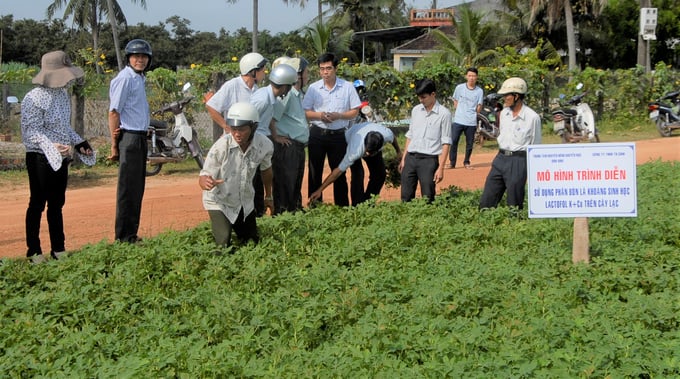
Model of organic fertilizer for peanuts in Cat Hiep commune (Phu Cat district). Picture: VDT
By 2013, Binh Dinh had converted more than 3,630 hectares to upland crops on inefficient rice land, but still only achieved 54% of the plan. At the beginning of 2014, the area of crop restructuring in Binh Dinh increased to 5,433 ha, a good sign!
Going forward, crop restructuring in Binh Dinh is becoming increasingly attractive to farmers, especially in areas where they do not actively irrigate and grow rice with low efficiency. After the conversion to dry crops with less need for irrigation, incomes increased, gradually the conversion spread far from the plains to the mountains, until now.
By 2022, Binh Dinh will continue to convert 3,078 hectares of rice land into dry crops, including 1,047 hectares of peanuts, 917 hectares of vegetables, 541 hectares of grass for cattle, corn (maize) 104 hectares, all kinds of beans 27ha. The efficiency of converting upland crops to rice land brings multiple times higher income. In addition, converting dried fruit to rice land saves water for irrigation, crop rotation helps improve soil, and limits pests and diseases.
At the beginning of 2023, Binh Dinh registered the conversion of 1,775 hectares with the Ministry of Agriculture and Rural Development, of which 1,735 hectares were converted to upland crops, 36 hectares to perennial crops and 4 hectares to rice combined with aquaculture. At the same time, Binh Dinh promulgated guidelines to promote plant structure transformation and support technology transfer through appropriate models.
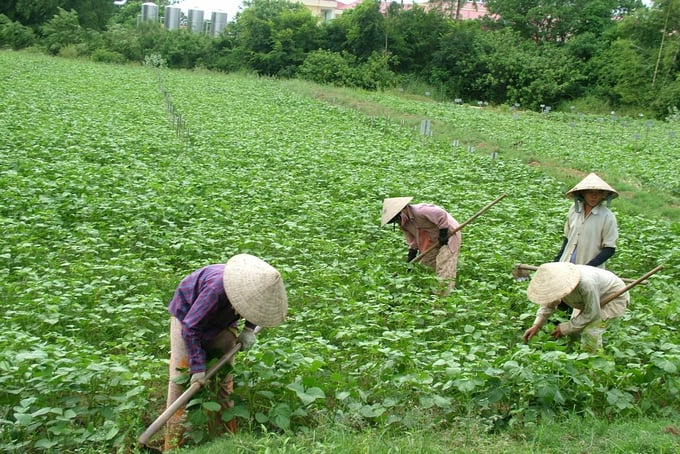
The inefficient conversion of rice land has given Cat Hiep community a breakthrough. Picture: VDT
According to Mr. Kieu Van Cang, Director of Binh Dinh Plantation and Crop Protection Sub-department, this unit is coordinating with communities to study and develop a plan to change crop structure in 2023 depending on the season to ensure crop production fit adapts to each location and the production conditions.
Binh Dinh will prioritize crop conversion in accordance with local water supply capacity and natural conditions; replacing crops with low economic efficiency with crops with higher economic efficiency, thereby increasing profit per unit area; Appropriate production models for adapting to climate change are being set up in the transition zone.
In fact, Binh Dinh makes great efforts in transforming plant structure, while creating large specialized agricultural areas, suitable for the use of raw material areas for connecting chains, increasing profits for people. So far, however, Binh Dinh has not attracted many companies and investors to get involved in the chain of production and consumption of dried fruit, the consumption of the products still depends on traders with precarious purchases.
Ten years thanks to beans changing life in the poor country
When I see the smile on the dark face of Mr. Nguyen Dinh Phi in Hiep Hoi Village, Hoi Van Village, Cat Hiep Township (Phu Cat District), which could not be brighter, I understand that he loves peanuts very much, when it comes to peanuts This plant. But how can you not love when Phi is only 47 years old this year but has been clinging to the peanut tree for almost 25 years. “As a child, I followed my father to harvest peanuts, grew up with peanuts as the main source of family income and have continued to do so to this day,” recalls Mr. Phi.
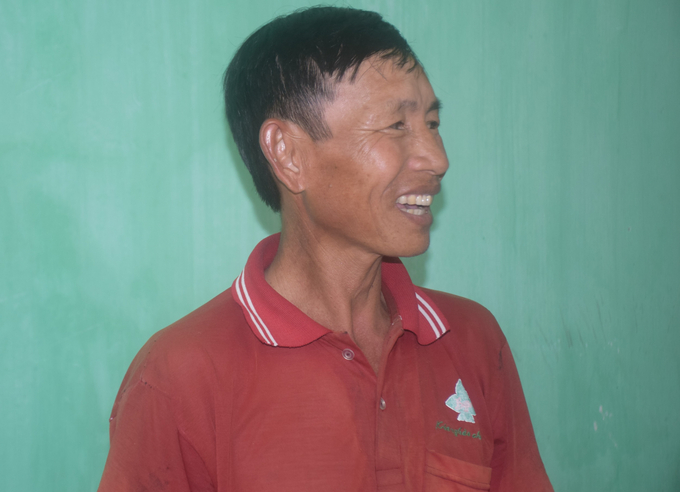
The beaming smile of farmer Nguyen Dinh Phi growing peanuts on 2 hectares in Cat Hiep (Phu Cat district). Picture: VDT
Mr. Phi currently produces 2 ha of peanuts in an area far away from the two irrigation canals of Van Phong and Thuan Ninh. Since there is no direct irrigation system, Phi dug wells 3-4 m in diameter wide and tens of meters deep to obtain water for irrigation.
From a barren sandy land, the peanuts grown in Cat Hiep now have the highest yield in the country. In order to achieve such a high yield of peanuts, in the past period, Cat Hiep farmers have been continuously trained by the functional sector, the process of making cassava (cassava) infused peanuts and pest control. Thanks to the gradual capture of scientific and technical advances and the synchronous application, the model of mixed cultivation of peanuts with noodles in Cat Hiep brings high efficiency.
According to farmer Nguyen Dinh Phi, the electricity grid reached Cat Hiep township in 2000, when people were digging wells to pull irrigation pipes for peanut fields. This type of overflow irrigation is both water consuming and labor intensive. A stake of peanut farmers has to wade through the field for 1 hour to fill with water. Now 98% of the peanut farmers in Cat Hiep have switched to sprinkler irrigation with fixed nozzles, saving both water and labor.
“The investment of installing 1 stick peanut automatic sprinkler irrigation system is about VND 5 million, the service life is 5 years. Farmers no longer need to go to the field, just stay at home to do other things, turn on the circuit breaker to water the peanut fields in time, and turn off the water in time. 1 stick of peanuts for the baby to fling about 1 hour is enough water,” Phi said.
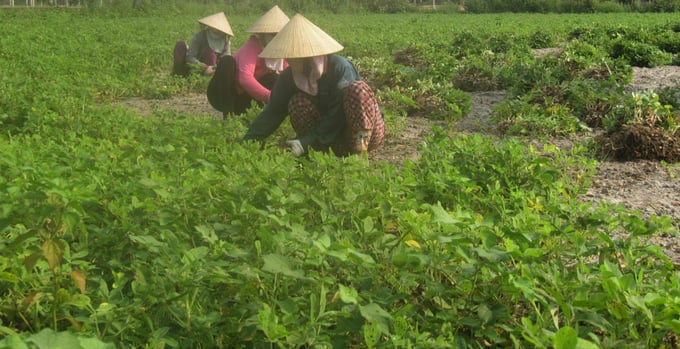
The peanut yield from the barren sandy soil in Cat Hiep township is now among the highest in the country. Picture: VDT
The Cat Hiep farmers’ peanut production techniques are also now very different from the past. In the past, people tried to take good care of peanut trees, but in fact, good beans only grow with leaves, but rarely bear fruit, now farmers are changing the way they take care of them for high efficiency.
Cat Hiep farmers now mainly use lime, phosphorus and organic fertilizers, but rarely use chemical fertilizers as before, according to Mr. Luong Van Khoa, deputy head of the Department of Agriculture and Rural Development of Phu Cat District. The growing time of peanut plants is 90 to 100 days. At least 20 days before sowing, farmers mainly fertilize with organic fertilizer, then sprinkle with lime to quickly reduce the pH in the lime, while improving the soil, plowing and drying the soil.
After sowing, the bean bush develops, the bean leaves absorb the manure immediately, so it grows green in the first month, focusing on branching and flowering. From the 2nd month, people prevent the dust from spreading to the wire and leaves by stopping fertilizing and only using organic products to stimulate flowering bean plants. If the buds are not concentrated, the fruit percentage will likely be low, only about 30%, the remaining 70% are young fruit. Thanks to improved production methods, peanuts in Cat Hiep have very high yields.
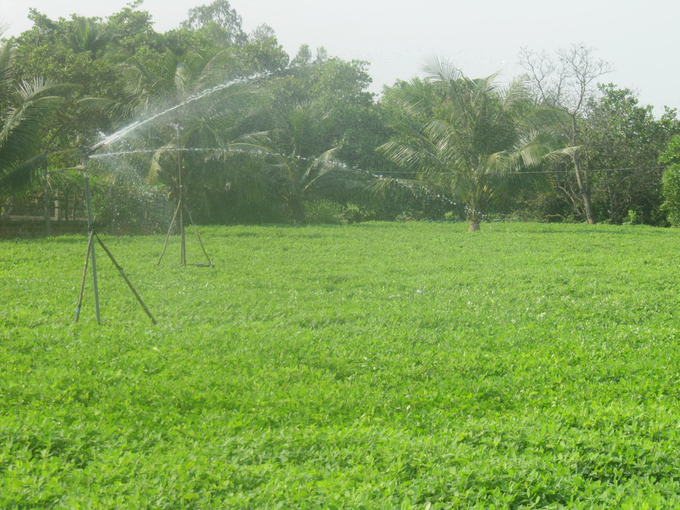
Currently, 98% of the peanut acreage in the Cat Hiep community is irrigated with automatic sprinklers. Picture: VDT
According to Ms. Nguyen Thi To Tran, Deputy Director of the Binh Dinh Ministry of Agriculture and Rural Development, Cat Hiep is the commune with the most concentrated peanut cultivation area in Binh Dinh province and also the place where peanuts have the highest yield in the Country.
The peanut tree has “changed the life of farmers on sandy soils”, is a key crop that brings high economic efficiency and contributes to success in transforming the plant structure in the region. It’s also a harvest that’s giving a new look to the land that used to be called “the land of the dogs that eat rocks, of the chickens that eat salt,” with vast fields of peanuts and spacious homes of bean field owners.
“In the past, Binh Dinh Provincial People’s Committee linked a deal with Cat Hiep farmers to buy peanut products. Back then, companies bought fresh at VND 10,000/kg, while traders bought up to VND 14,000/kg, farmers applied to companies for a price increase but failed, so this connection collapsed. Today, the production of Cat Hiep peanuts mainly depends on private traders. As for the noodles, the starch processing companies in Van Canh and Vinh Thanh districts come to the area at harvest time to set up the shopping table, so you don’t have to worry,” said Mr. Dao Van Chung, vice chairman of the Municipal People’s Committee Cat Hiep.

